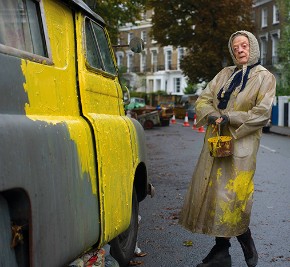Each other’s business

In Marilynne Robinson’s novel Lila, a young woman reared by drifters in the Midwest and experiencing homelessness finds herself in the warm company of an old clergyman who later becomes her husband. Their initial interactions often occur over coffee, with the young woman posing theological questions of the sort one might hear from children—that is, questions that sharply arrive at the heart of matters obscured by the ignorance of adulthood.
Robinson writes after one of their meetings, “She didn’t always remember yet to say thank you for the coffee, thank you for your time and your trouble. He walked her to the door and opened it for her, and she forgot to thank him for that. He looked tired, and as though he was sorry the conversation had ended.”
Read our latest issue or browse back issues.
A similar scene takes place in The Lady in the Van, the film adaption of British playwright Alan Bennett’s memoir and play based on his experiences befriending a woman experiencing homelessness. She likewise never acknowledges Bennett’s kindness to her that spans more than 15 years.
In an interview this year on NPR’s Fresh Air, Dame Maggie Smith, who plays the homeless woman named Mary Shepherd, remarks,
I think she would never have thanked anybody. I don’t know if it was because that’s how far she got in her existence that she was completely single-minded. I don’t think she thought or cared about anybody. She was so—I would imagine—so desperate to just exist. And then she must’ve existed in this completely separate world.
The film, like Robinson’s Lila, illustrates this singular focus to exist and the notion that despite the exhaustion of all cares on one’s self, a continuation of life still requires caring from others. “Existence can be fierce,” Lila says to herself. Bennett’s story of his time with Shepherd shows that communion can quell this savage nature of surviving.
Shepherd appears on Bennett’s (played by Alex Jennings) street in Camden, a borough in northwest London, in the 1970s. Parking her dilapidated van on the street in front of various houses, she makes her home in the back of her vehicle and eventually settles on the curb outside Bennett’s residence (filmmakers shot at the location of Bennett’s former home in Camden). When questioned about how she chooses her next parking location, Shepherd tells one resident on the street that she receives guidance: “The Virgin Mary. I spoke to her yesterday. She was outside the post office.” Bennett, perturbed at the new eyesore in front of his home and the nuisance of Shepherd’s odd behavior, attempts to shoo her away in his polite, nonconfrontational, English manner.
She ignores his efforts, and after tickets from authorities that label her home a danger to public health and many instances of cruel behavior from passers-by, Bennett invites her to park her van in his driveway. “These attacks, I’m sure, disturbed my peace of mind more than they did hers,” Bennett recounts in a 1989 essay in the London Review of Books. She reluctantly moves, claiming, “You’re not doing me a favor, you know. I have got other fish to fry,” and stays beyond the next decade.
The rest of Bennett’s story treats his audience to his humorous, frightening, doting, annoying, joyful, and saddening days with Shepherd—fickle emotions that mimic life’s relationships more accurately than the putting on of a patronizing patina of niceness for the vulnerable. In other words, viewers see Bennett treating Shepherd as a human.
“Mary, as you call her, is a bigoted, blinkered, cantankerous, devious, unforgiving, self-serving, rank, rude, car-mad cow,” Bennett says, “which is to say nothing of her flying feces and her ability to extrude from her withered buttocks turds of such force that they land a yard from the back of the van and their presumed point of exit.” Yet soon after this rant, Bennett secures a doctor for Shepherd because he worries about her health.
His outburst also illustrates the film’s second story line—the “you” whom Bennett addresses is himself. The film portrays Bennett in the same room with himself—the two versions of himself speaking to each other.
Bennett explains in the foreword to his screenplay, “The truest part of what we bill as A True Story is the sight of Alan Bennett at the desk watching the view of Alan Bennett with the mess spilling out of the van.” One Bennett depicts his life as a writer, and the other Bennett depicts his life as a liver, or his own messy human. Writers know exactly this duality, but how does the meta-portrayal play out on film? When Bennett-the-human erupts about Mary the cantankerous car-mad cow, Bennett-the-writer responds from his desk, “Though of course you didn’t say any of that.”
In its story of how a writer writes a story unfolding in front of his face, the film is brilliant. It’s also quite British—Anglophiles will love the scenes in Camden, sharp dialogue, lack of feelings on sleeves, and Bennett’s English way of being in the world. His writer self, addressing his human self, says, “People would think that was because you were too nice, it’s actually because you’re too timid.” Bennett the human responds, “Yes, though this being England, timid is good too.” Moviegoers saddened by the recent ending of Masterpiece’s Downton Abbey and the disappearance of the dowager countess from their homes will enjoy seeing Smith’s magnificent portrayal of Shepherd.
Widely released in the United Kingdom last November and in the United States with a limited release in January of this year, the film is not Smith’s first time playing the lady in the van. Nicholas Hytner, who directs the BBC-produced movie, also directed the original 1999 stage production in London written by Bennett. Smith portrayed Shepherd on the stage, earning her a Best Actress nomination at the 2000 Olivier Awards, and she lent her voice as Shepherd in a 2009 BBC Radio 4 adaptation.
“[W]e are each other’s / harvest: / we are each other’s / business: / we are each other’s / magnitude and bond,” American poet Gwendolyn Brooks writes. The Lady in the Van shows what happens when we make another, or in Shepherd’s case, an other, our business. Nothing short of unsentimental empathy, compassion, and ultimately grace emerge when we bring another into our lives, whether by letting her use his loo, as Bennett initially did, or by befriending her until angels surround her and saints welcome her in peace, as Bennett eventually did.
Early in the film, Shepherd and Bennett have the following exchange:
Shepherd: You’re not St. John, are you?
Bennett: St. John who?
Shepherd: St. John. The disciple whom Jesus loved.
Bennett: No. My name’s Bennett.
Shepherd: Well, if you’re not St. John, I need a push for the van. It’s conked out, the battery possibly. I put some water in, only it hasn’t done the trick.
One can imagine that this type of film walks the fine line between sobriety and sentimentality. Sentimentality, Frederick Buechner writes, “is to look only at the emotion in it and at the emotion it stirs in us rather than at the reality of it, which we are always tempted not to look at because reality, truth, silence are all what we are not much good at and avoid when we can.” Bennett’s and Shepherd’s failing to realize that they both are disciples whom Jesus loves ensures that Bennett’s story remains on the right side of this line—the side that looks at the reality of loving one’s neighbor.





